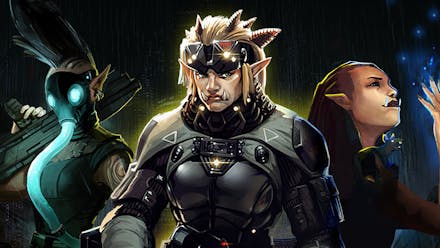Platforms: Xbox Series X, Xbox One, PS5, PS4, Nintendo Switch
The Shadowrun series has quite the storied lineage – originally a tabletop RPG that gained popularity thanks to its unique blend of cyberpunk and fantasy influences, videogame spinoffs have appeared on consoles as far back as the SNES and Mega Drive. With the rights hopping between publishers over the last 30 years, there's been little consistency, with games ranging from action adventures to first-person shooters, and even Japanese visual novels. Then, the first game in this trilogy, Shadowrun Returns, broke Kickstarter records in 2012 and established a more cohesive identity for the series as authentic role-playing games bolstered with tense, turn-based tactical combat.
Originally PC exclusives, the modern series has seen ports to Android and iOS devices, but has been absent from consoles until now. A decade on from the original release, can these genre mash-up classics pass muster for modern players? Largely, yes – although this collection isn't the glossed-up remaster fans might expect.
Publisher Paradox Interactive's release of Shadowrun Returns, Dragonfall: Director's Cut, and Hong Kong: Extended Edition makes a few welcome overhauls for TV play, chiefly in the controls. These are welcome – moving your customised character with a controller thumbstick just makes the whole game feel more fluid than it ever did on a mouse and keyboard, while making selections or switching between weapons in combat is a quick tap of a button.

Visuals get a bit of a bump, with the option to boost resolution to 4K in the game's settings, but the painted backgrounds of developer Harebrained Scheme's dystopian fantasy world holds up either way. However, even in 4K, the text-heavy games still feel designed to be played up close on a monitor, rather than a room away on a TV. Lengthy descriptions of characters met or locations entered are beautifully written and brilliantly establish tone, detail, and even trust – hinting at dialogue options or interactions to pursue for particular results – but with everything boxed up on the left of the screen, you'll be squinting even on a big-screen TV. Beyond those scant updates though, these games are essentially untouched. It's not even a 'trilogy' release in the sense of being an actual package – each game is its own installation, and there's no bonus or anniversary material. It's about as barebones as can be.
A welcome console appearance for these three games, but it's a shame it doesn't feel like more of a celebration.
Thankfully, the games themselves pass the test of time. Each still offers an engrossing cyber-noir tale that draws you into Shadowrun’s universe, where fantasy creatures such as Elves and Trolls reappeared in the modern world after the return of magic. Unfortunately, they find themselves trapped in the same capitalist hellscape as us meagre humans, with many merging cybernetics with magic to become 'Shadowrunners' – espionage specialists often employed by corporations to steal secrets from rivals. Designing playable characters in all three games allows you to choose between any of the five species – Humans, Elves, Dwarves, Orcs, and Trolls – and customise them as you see fit. While there are certain pre-made archetypes to choose from – street samurai who focus on weapons mastery, or deckers who tailor their bodies for hacking on a whim, for instance – there are no strict classes, and skills can be unlocked in all areas by any character. It's a great approach, and allows considerable freedom and flexibility in how you engage with the game world.
While Shadowrun Returns’ campaign is the shortest – around 10-12 hours – it has a strong narrative and is good introduction to the world, pulling you into the murky underbelly of Seattle to investigate the murder of an old friend. Dragonfall (dealing with an attempt to resurrect a fearsome dragon) and Hong Kong (unravelling a conspiracy involving police, corporations, and your own estranged family) are meatier tales, and both allow you to control a whole team of shadowrunners as opposed to hiring support characters, which affords more personality in the cast and sparkle in the dialogue.
Combat is largely unchanged across the three games though – each offers XCOM-style battles where Action Points are spent to move characters across the top-down maps, taking cover where possible, and using a mix of weapons and magic to defeat enemies. While the structure is similar, Shadowrun’s battles are a bit nippier than XCOM’s though, and can sometimes be avoided entirely by making the right choices beforehand. Dragonfall and Hong Kong mix things up slightly, introducing tweaked mechanics such as sneak attacks and ley-lines that can enhance magic in combat, but it's a fairly consistent experience across the trio.
Overall, this release marks a welcome console appearance for these three games, but it's a shame that Shadowrun Trilogy doesn't feel like more of a celebration. It's a basic port with minor tweaks, more bundle than actual trilogy, and while combat and exploration translate well, the walls of text mean these are always likely to feel better played sat at a PC than on a couch.
